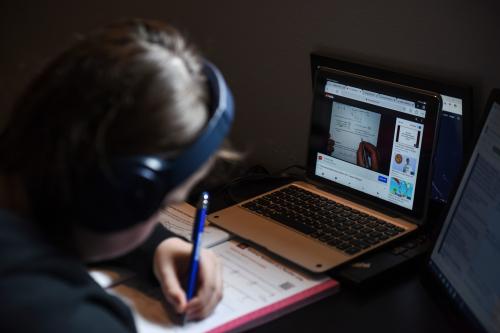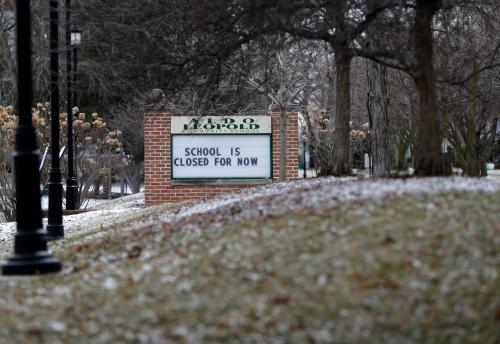In the midst of an unprecedented crisis, it can be hard to see more than a few days into the future. It’s as if we were wandering around in a dense (and deadly) fog.
Some commentators are predicting that this will change the way we live; one even predicts that it will “change us as a species.” Perhaps, but in what way? We will certainly remember this time for the rest of our lives. At least briefly, we will appreciate the smaller things in life a bit more. But will it really change anything fundamentally, for the long-term? If so, how?
People wondered the same after Hurricane Katrina in New Orleans. Life here is defined as “before Katrina” and “after Katrina.” No one in New Orleans would claim that the city hasn’t changed. The city is better protected now from improved levees and other water management. The population is smaller (and whiter).
But when people suggest “things will never be the same,” they’re talking about something deeper, about how we live—about our habits, norms, and ways of living. For parents, teachers, and students, it’s possible that some aspects of schooling might not go back to the way they were before.
Possible changes in schools
I’ve been thinking about what we’ve learned from Katrina and how life will change—especially how schools will change. After Katrina, New Orleans shifted to what eventually became the first all-charter-school city in the country. No, I’m not predicting that we’ll do anything like that because of coronavirus. But, as I explain in my upcoming book, “Charter School City,” there were many powerful forces in New Orleans that made the school reforms a reality. Some of these forces are powerful now as well.
With COVID-19, schools are rapidly changing the basic way they do their work. Some have become old-fashioned correspondence schools, with the vast majority of interaction happening by written mail. Others have tried to recreate the school setting online using digital tools like Zoom. Others are in-between, directing students to online tutoring and practice programs, and posting videos. Most people think that they just want to get things back to normal. That makes sense. After all, the schools didn’t do anything to cause the crisis. So, why change them?
That’s what many thought after Katrina. The schools didn’t cause the devastation, so why change them? Yet, change they did. The state took over almost all the city’s public schools, eventually turning their operations over to nonprofit charter organizations. Teacher tenure and the union contract ended. The attendance zones, which assign students to the schools they attend based on where they live, were eliminated so that families had a chance to choose any schools they wished. Only a handful of cities had ever done any one of these things before—New Orleans did all of them at once.
I’m going to focus here on the “school choice” part of the New Orleans reforms because it’s especially revealing. After Katrina, the city essentially had to eliminate attendance zones and switch to school choice because the returning population was too dispersed for any “zone” to have enough students. Also, families were switching from one temporary home to another; the zones would have required students to constantly change schools. The switch to school choice was therefore partly a practical one—to deal with the crisis. School choice suddenly became necessary.
And guess what happened? Families got used to having choice. While there is growing concern about the distance children have to travel to go to school and the district is starting to allow neighborhood to be one factor in assigning students, there has been almost no conversation at all about going back to traditional attendance zones—even though the storm and most of its effects are long gone.
The shift to choice also led to other changes. For example, the end of attendance zones means that most students no longer go to the same schools as those who live down the block. This means, further, that neither children nor parents in the same neighborhood develop the same kinds of community bonds as they did before. Also, as choice advocates argue, choice allowed students to match their needs to school offerings.
What lessons can we learn from this?
So, what does the New Orleans/Katrina case teach us? First, crises force us to adapt. Katrina forced change, and that change led to school choice. In the current crisis, COVID is forcing parents to be teachers and forcing everyone—students, parents, and teachers—to adapt to online learning tools.
Second, people get comfortable with some of these adaptations. Katrina made school choice comfortable in New Orleans. Likewise, while families are now stressed out trying to educate their children, they are also experiencing educational methods and tools that they’ve never seen before. They are getting more accustomed to them.
This is not to say that all the online tools are very good. Many are not. But consider the following: Suppose a teacher tries three online tools during the crisis. She likes tool A, dislikes tool B, and is indifferent on tool C. This doesn’t exactly sound like a recipe for mass transformation, does it? Well, actually, if the crisis had never happened, the teacher would never have known about any of these tools and wouldn’t have used B or C anyway. The key is that the teachers (and perhaps students and parents) now want more of A, and that could be transformative.
Third, our adaptations have indirect effects that lead to other changes. The necessary shift to school choice has changed our neighborhoods in ways that were not intended. In the current crisis, the shift to online tools may also have indirect effects.
The potential long-term shifts from COVID-19
Below, I apply the above logic to several policy areas that I’ve seen discussed recently in the context of coronavirus. The first two topics—online tools and fully online learning—are the ones that come to mind first. The rest are potential long-term shifts that might fall more into the “indirect” bucket.
Use of online tools? It should be clear from my arguments above that schools will make much greater use of online tools. Most students in the country will soon have laptops and some type of internet access (though the digital divide will remain a significant concern). Teachers are going to like many of the tools out there, and they will have an easier time using them now that students have some experience with them. As Dave Deming recently pointed out, online tools can be helpful complements to in-person instruction—instead of a replacement for it—allowing teachers to focus more on engaging students and mentoring them.
A shift to homeschooling and fully virtual instruction? There may be some shift in this direction. Families will get more accustomed to online learning. However, this approach has the significant disadvantage that families have to play the role of hall monitor and teacher. Few families want or can afford that, given their work schedules and other responsibilities. Moreover, research consistently suggests that students learn less in fully virtual environments. In-person, teacher-led instruction simply has too many advantages.
A shift to charter schools? A key question is: Which schools will respond better to the current crisis? It could be that traditional public schools respond better, meaning they provide better educational services to children and their families. This is possible because they are designed to have greater capacity. They have IT departments and directors facilitating special education, procurement, and more. They benefit from economies of scale and expertise. On the other hand, charter schools have fewer rules to follow. With fewer government rules and more limited union contracts, charter schools can be more nimble in responding to a crisis.
It’s too early to tell which sector will win out. One recent report suggests that charter management organizations (CMOs) have switched to online instruction more aggressively than traditional public schools, though most charter schools aren’t actually run by CMOs. Also, CMOs often receive substantial additional funds from philanthropists, giving them an advantage.
But if one sector responds better, this will be a meaningful victory, and one that parents will no doubt notice. The schools that respond best can expect more parents to select them, and expect more political support.
A shift to private schools? Everything above about charter schools also applies to private schools with one exception: Private schools are likely to get pummeled financially. With the exception of the small fraction of students attending with vouchers, families have to pay tuition. While the middle-class families that attend private schools will not be as hard hit by the COVID-19 economic crisis, everyone will be meaningfully affected. Over the next year, it is likely we will see a large spike in private school closures.
A shift to competency-based learning? Some education experts have argued that this may be the big winner of the current crisis. However, I think that’s unlikely. As with homeschooling, competency-based approaches have severe limits. While they let students learn at their own pace, competency-based approaches atomize learning and rely heavily on standardized tests. Students provide their competency, and can go on to the next topic, only by passing a test. Competency-based learning is “personalized,” in the sense that instruction is adapted based on existing skills, but, again, within the confines of the tests. Some of these are better than others, but I still don’t believe the more competency-based approaches will be the ones teachers and students gravitate toward in the current crisis. Competency-based learning suffers too much from the same problems as high-stakes testing more generally, which has fallen out of favor.
Yes, we will need more competency-based approaches in the short run to determine which students will be promoted to the next grade, given the lost learning time. But a significant long-term shift to online learning seems less likely.
Shifting roles of students, parents, and teachers? A shift to some online tools could shift the role of teachers, making them more like coaches and mentors. They can point students to very good online lectures and then be there to provide guidance and feedback, and to make connections across topics. The roles of students and parents could also shift. Now that they have more places to look, they may be more likely to try and address learning needs on their own. When roles change, everything else can change with it—though in less predictable ways.
One additional indirect effect: The politics of education
Of course, the main change in schooling that occurred after Katrina was that a few leaders decided that the local school district should no longer be given the responsibility to educate children—that’s why my book is called “Charter School City,” not “Traditional Public School City.” But this wasn’t mostly about the forces above. It was about politics.
I don’t mean that in a bad way. Politics is about how we make collective decisions. It involves values and power struggles. In a later post, I will consider how the COVID-19 crisis might (or might not) reshape the politics of education. Could this lead to big changes in public policy that aren’t yet evident? Might we see reductions in state and federal regulation? More flexibility for students who choose courses and tools?
The shape of the New Orleans reforms was unclear until several months after the storm made landfall. It is also early in the current crisis, and we are still wading through the dense fog. It is hard to know how tens of millions of students, three million teachers, and thousands of educational organizations will act in the months and years ahead. However, it is useful to start thinking about what might be coming—and which of these changes we should be encouraging.
The Brookings Institution is committed to quality, independence, and impact.
We are supported by a diverse array of funders. In line with our values and policies, each Brookings publication represents the sole views of its author(s).








Commentary
How will COVID-19 change our schools in the long run?
April 24, 2020